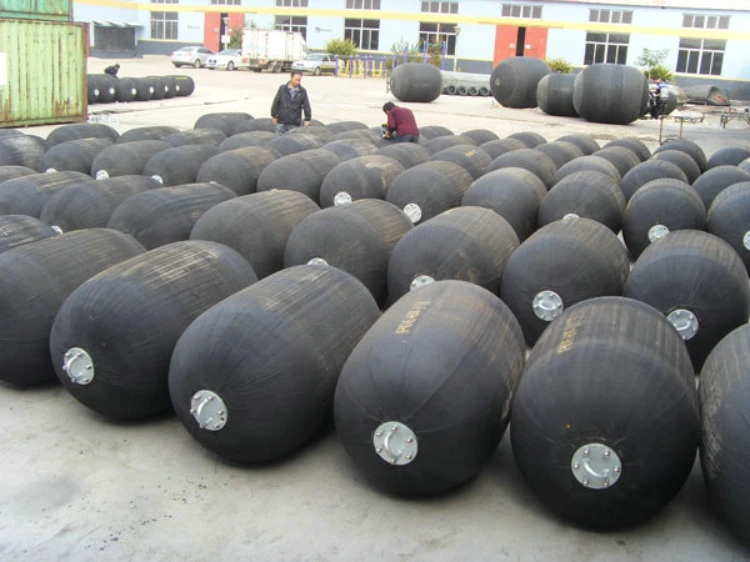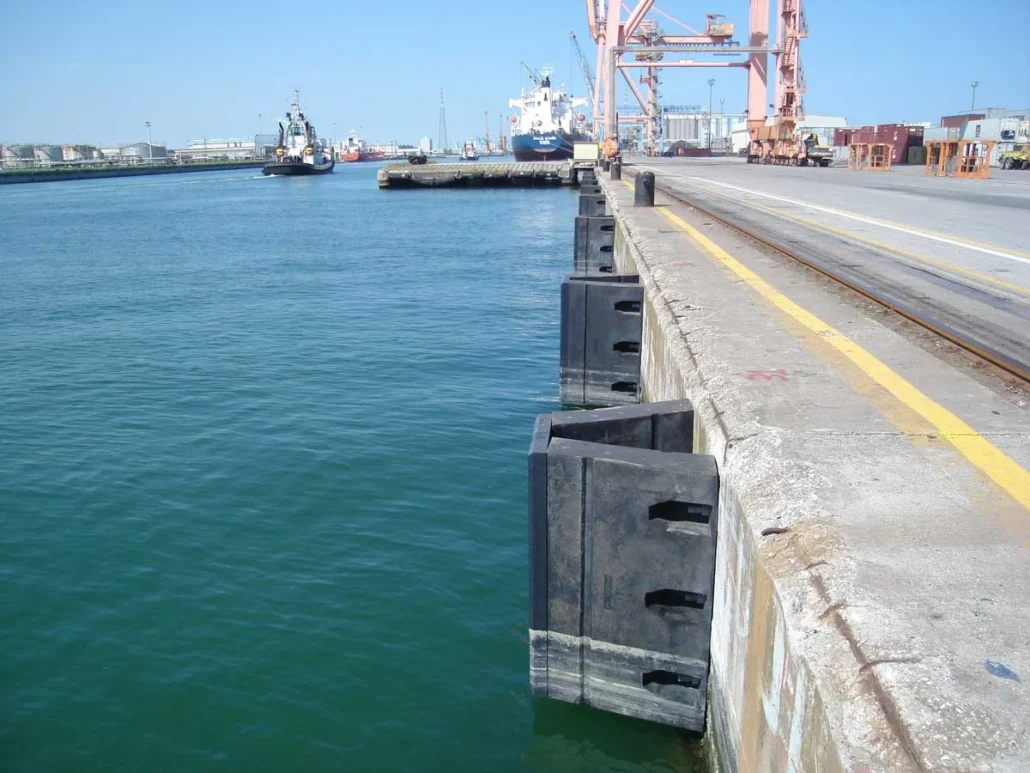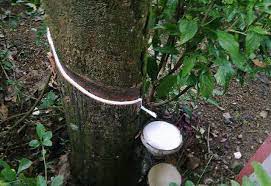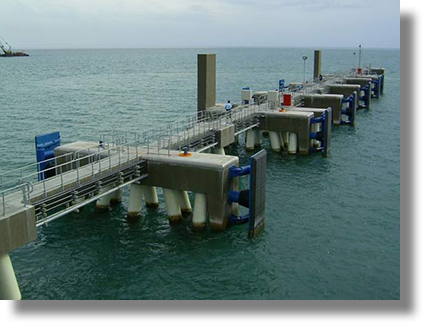Ⅰ. Aplicación de las defensas marinas
Los productos de caucho de protección marina (defensas marinas) son un tipo de productos de caucho utilizados para proteger barcos e instalaciones portuarias. Suelen instalarse en muelles, embarcaderos, barcos y otras estructuras marinas. Las defensas marinas absorben y mitigan la fuerza de colisión entre un barco y un muelle u otra estructura.
Las estructuras marinas incluyen muelles, embarcaderos, buques y otras estructuras marinas. En el entorno marino, el atraque de buques y la carga y descarga de mercancías requieren las instalaciones y estructuras correspondientes. Estas instalaciones y estructuras se denominan colectivamente estructuras marinas.

1. Estructuras marinas
(1). Muelle
Los muelles son instalaciones terrestres o acuáticas para atracar buques y cargar y descargar mercancías. Los ingenieros suelen diseñar estructuras robustas y profundidades de agua adecuadas. Esto permite a los muelles acoger embarcaciones de distintos tamaños y tipos.
(2). Muelle para barcos
Un muelle para embarcaciones es una instalación utilizada para la reparación, el mantenimiento y la construcción de embarcaciones. Suelen ser piscinas o zonas cerradas. Los muelles tienen capacidad para controlar los niveles de agua y el drenaje. Los muelles pueden albergar grandes embarcaciones y proporcionar el equipamiento y los servicios necesarios.
(3). Barco
Un buque es una gran embarcación utilizada para transportar personas, mercancías u otros objetos por el agua. Los principales tipos son los cargueros comerciales, los transbordadores de pasajeros, los petroleros, los pesqueros y otros varios.
(4). Otras estructuras marinas
Además de muelles, diques y barcos, existen otras estructuras marinas. Por nombrar algunas, están los diques flotantes, las turbinas eólicas marinas, las plataformas petrolíferas marinas, etc. Estas estructuras están sometidas a diferentes fuerzas y desafíos en el entorno marino.
2. Colisiones entre estructuras marinas
Las colisiones entre estas estructuras marinas pueden producirse en las siguientes situaciones:
(1)Atraque de buques:
Pueden producirse colisiones cuando un buque se aproxima a un muelle o dársena. Debido a diversos factores (por ejemplo, viento, mareas, errores de maniobra, etc.), al operador le resulta difícil controlar el buque con precisión.
(2)Maniobra del buque:
En puertos y aguas muy transitados, pueden producirse colisiones entre embarcaciones. Especialmente al girar, detenerse o cambiar de velocidad.
(3) Condiciones meteorológicas adversas:
Los puertos son tranquilos en la mayoría de los casos. Pero las condiciones meteorológicas del mar son muy complejas. A veces, condiciones meteorológicas severas, como vientos y olas fuertes, pueden afectar al puerto y al barco. Los vientos y olas fuertes pueden provocar una colisión entre el barco y el muelle.
Estas colisiones pueden generar una fuerza considerable. Muchos factores, como el tamaño del buque, su velocidad, su ángulo y la zona de contacto con la estructura, determinan la magnitud de esta fuerza. En ocasiones, esas fuerzas son suficientes para causar daños graves y suponer una amenaza para la seguridad del personal y el medio ambiente.
Por esta razón, los productos de caucho de protección marina (por ejemplo, defensas) se utilizan a menudo para mitigar las fuerzas de colisión en la ingeniería marina y la construcción de puertos. Estas medidas son esenciales para proteger la seguridad de buques y estructuras.
Ⅱ. El uso principal de las defensas marinas
Los productos de caucho de protección marina pueden reducir los daños por colisión en el casco y las instalaciones del muelle. Suelen montarse en muelles, embarcaciones y otros lugares de contacto. Estos lugares incluyen bordes de muelles, pilares de puentes, paredes de muelles, etc. Estos productos de caucho sirven para dos propósitos principales:
1. Absorción y dispersión de fuerzas:
Los productos de caucho son elásticos y absorben energía. Absorben y dispersan las fuerzas de colisión y reducen el impacto.
2. Amortiguación:
Actúa como amortiguador en caso de colisión. Reduce la fuerza del impacto directo. Reduce el riesgo de daños. Prolonga la vida útil de la estructura.
Estos productos de caucho pueden minimizar considerablemente los daños a los cascos y a las instalaciones del puerto deportivo en caso de colisión. Elegir el caucho adecuado e instalarlo correctamente puede minimizar enormemente los daños. Además, proporcionan un entorno de atraque y carga más seguro. Proporcionan un atraque estable y unas condiciones de carga y descarga seguras para las embarcaciones. Estos dispositivos protegen a las personas y el medio ambiente.

Ⅲ. Propiedades y aplicaciones de las defensas marinas de caucho
1.Propiedades del guardabarros de caucho
Los materiales utilizados para estos productos de caucho suelen tener excelentes propiedades. Este material suele tener las siguientes propiedades:
- Alta resistencia
- Resistencia a la abrasión
- Resistencia a la corrosión
- Propiedades de absorción de energía
Estas propiedades prolongan enormemente la vida útil del guardabarros. Los fabricantes o compradores deben tener en cuenta muchas ventajas a la hora de fabricar o adquirir un guardabarros de goma. Pero garantizar su uso a largo plazo es una de las consideraciones más importantes. Los entornos marinos complejos pueden crear perturbaciones en el dispositivo.
(1)Alta resistencia:
Los materiales de caucho tienen una excelente resistencia a la tracción. Además, también deben ser resistentes al desgarro. Esto se debe principalmente a que el guardabarros puede soportar grandes fuerzas y tensiones.
(2) Resistencia a la abrasión:
Los materiales de caucho tienen una buena resistencia a la abrasión. Los guardabarros de goma suelen estar sometidos a una fricción prolongada. Una buena resistencia a la abrasión mantiene la integridad del guardabarros y garantiza que éste cumpla su función. Y puede garantizar que el guardabarros cumpla su función.
(3) Resistencia a la corrosión:
El caucho es un material orgánico. Hay muchos factores que pueden corroer el caucho en el medio marino. Por ejemplo, el agua de mar, la radiación UV y los productos químicos son corrosivos. Para maximizar la vida útil de las defensas, es necesario utilizar materiales duraderos. Por lo tanto, es importante utilizar materiales que puedan resistir el duro entorno.
(4)Elasticidad:
La buena elasticidad caracteriza a los materiales de caucho. Elegimos el caucho para fabricar la defensa principalmente por esta característica. En el proceso, los barcos pueden aplastar o golpear la defensa, sometiéndola a mucha presión. La gran elasticidad de la defensa de caucho le permite soportar esa presión. La defensa de caucho se recupera rápidamente tras la aplicación de la fuerza, sufriendo una deformación elástica completa. Durante este proceso, el guardabarros absorbe la energía de la colisión, evitando que se produzcan daños.
(5)Absorción de energía:
Esta propiedad es similar a la elasticidad. Sin embargo, la elasticidad se centra en la magnitud de la deformación del guardabarros. La absorción de energía mide la cantidad de energía cinética absorbida por la defensa. Cuando un buque aprieta una defensa, ésta se deforma elásticamente. La defensa transforma la energía cinética del buque en energía potencial. La absorción de energía de la defensa determina cuánta energía cinética absorbe. Esto reduce el impacto sobre el casco del buque y las instalaciones del muelle.
2. Tipos de materiales de caucho
El material de caucho tiene muchas fuentes. En el contenido anterior, hemos introducido muchas propiedades de los materiales de caucho. Basándonos en ellas, podemos clasificar los materiales de caucho en varias categorías:
(1)Caucho natural:
Este caucho procede de los árboles del caucho. Los trabajadores cortan regularmente la corteza de los árboles del caucho. El árbol segrega una emulsión. Los trabajadores recogen esta emulsión. Las fábricas de caucho realizan una serie de procesos con la emulsión. El producto final es material de caucho natural.

(2)Caucho sintético:
El nombre de este material refleja su origen. Se trata de un material de caucho artificial. Químicamente, se fabrican todo tipo de materiales de caucho.
-
-
- Caucho nitrílico
- Caucho estireno-butadieno
- Goma de neopreno
-
(3)Poliuretano:
También es un material sintético. Este material tiene una resistencia extremadamente alta. Y sus propiedades químicas determinan su resistencia a la abrasión.
3. Cómo medir las propiedades de un material de caucho
En el proceso de producción de un guardabarros, la fábrica tiene que elegir el material de caucho adecuado. A la hora de elegir un material, la elasticidad y la absorción de energía son las propiedades más críticas. Algunos valores pueden reflejar con precisión estas dos propiedades.
(1)Módulo de elasticidad:
Medida de la capacidad de un material para volver a su estado original tras ser sometido a una fuerza. Un módulo de elasticidad más bajo indica una mayor elasticidad.
(2) Resistencia a la tracción:
Un material se somete a fuerzas externas durante el estiramiento. La resistencia a la tracción determina cuánta fuerza puede soportar el caucho.
(3)Alargamiento a la rotura:
Los materiales de caucho no pueden soportar fuerzas de tracción indefinidamente. Una fuerza de tracción suficientemente grande hará que el material de caucho se rompa. Cuando se produce una rotura, el material de caucho se extiende una cierta distancia. Esta distancia es el alargamiento de rotura. Este índice refleja la magnitud de la deformación del material de caucho.
Los productos de caucho tienen una estructura material especial. Esta estructura confiere a los materiales de caucho unas propiedades materiales excelentes. Los materiales de caucho pueden absorber y dispersar la energía de las colisiones. Los barcos y otras estructuras chocan a menudo con las defensas marinas. El material de caucho se comprime y se deforma elásticamente. Durante el proceso de deformación, la defensa absorbe y almacena la energía de la colisión. Posteriormente, el material de caucho vuelve rápidamente a su estado original. El proceso de restauración libera la energía almacenada en el caucho. Estas fuerzas habrían impactado directamente contra el muelle. Pero el material de caucho protege el muelle de esta fuerza. De este modo, las defensas de caucho crean un entorno más seguro para las operaciones de atraque y manipulación.
Ⅳ. Los tipos de defensas marinas
Existen muchos tipos de productos de caucho de protección marina. Aquí se presentan dos de los tipos más comunes:
- Defensa neumática
- Defensa marina de goma
Se utilizan ampliamente en ingeniería marina, construcción de puertos e industria naval. Las diferentes formas de los productos de caucho de protección marina tienen diferentes características y escenarios de aplicación:
1. Defensa neumática:
Por lo general, las defensas neumáticas se utilizan para la protección contra el contacto entre buques. Tienen buenas propiedades de absorción de energía y elasticidad. Las defensas de caucho redondas son adecuadas para diversos muelles y tipos de buques. Pueden proporcionar una protección fiable. Y lo que es más importante, las defensas neumáticas pueden minimizar eficazmente los daños a los cascos y las instalaciones del puerto deportivo.
2. Defensa de goma marina:
Las defensas marinas de caucho se utilizan habitualmente para proteger estructuras como pilares de puentes, muros de muelles, etc. Tienen una gran superficie de contacto. Las defensas marinas de caucho ofrecen una mayor protección al tener una mayor superficie de contacto.
Estas defensas marinas tienen diferentes formas. Además, puede haber algunas diferencias entre ellas en cuanto a prestaciones y precio. La diferencia exacta depende de factores como la calidad del material de caucho, el proceso de fabricación, el tamaño y el diseño. Por lo general, los tamaños más grandes, las formas más complejas y los productos de caucho de mayor calidad pueden ser más caros. Las compras deben elegirse en función de las necesidades específicas y el presupuesto.

